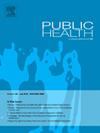儿科急诊科5岁以下儿童护理人员对COVID-19疫苗的犹豫
IF 3.9
3区 医学
Q1 PUBLIC, ENVIRONMENTAL & OCCUPATIONAL HEALTH
引用次数: 0
摘要
目的:5岁以下儿童SARS-CoV-2 (COVID-19)感染率较高,但疫苗接种率较低。我们的定性研究调查了6个月至4岁儿童的照顾者可能不愿为孩子接种COVID-19疫苗的原因。研究设计:定性研究。方法:我们招募了在南加州儿科急诊科就诊的6个月至4岁患者的护理人员作为方便样本。我们对护理人员进行了面对面的半结构化访谈,以探讨他们在为孩子接种COVID-19疫苗方面可能存在的任何犹豫。采访被记录下来,转录,必要时翻译,并编码。当主题达到饱和时,我们应用扎根理论方法来评估主题,并改编世界卫生组织战略咨询专家组疫苗犹豫决定因素矩阵模型,为确定的主题提供框架。结果:我们进行了20次访谈,其中两次是西班牙语访谈,并在17次访谈中达到主题饱和。我们将围绕疫苗犹豫的主题分为外部因素、以患者为中心因素和以疫苗为中心因素。外部因素包括信息来源和家庭/社区影响。以患者为中心的因素包括感知风险与收益比、护理人员信念、护理人员知识和意识。以疫苗为中心的因素包括疫苗安全性、疫苗效力、疫苗信息和接种障碍。结论:采用定性方法,我们获得了护理人员对5岁以下儿童接种COVID-19疫苗的想法的重要见解。我们确定了以前未在文献中发表的主题,这些主题可能是针对年轻儿科人群的COVID-19疫苗的。本文章由计算机程序翻译,如有差异,请以英文原文为准。
COVID-19 vaccine hesitancy among caregivers of children under five years old in a pediatric emergency department
Objective
Children under five years old have a high rate of SARS-CoV-2 (COVID-19) infection, yet rates of vaccination are relatively low. Our qualitative study investigated reasons why caregivers of children ages six months to four years old may be hesitant to vaccinate their children against COVID-19.
Study design
Qualitative study.
Methods
We enrolled a convenience sample of caregivers of patients aged six months to four years who presented for care at a pediatric Emergency Department in southern California. We conducted face-to-face semi-structured interviews with caregivers to probe for themes regarding any hesitations they may have regarding vaccinating their children against COVID-19. Interviews were recorded, transcribed, translated if necessary, and coded. When thematic saturation was achieved, we applied grounded theory methodology to assess for themes and adapted the World Health Organization Strategic Advisory Group of Experts model of vaccine hesitancy determinants matrix to provide a framework for the identified themes.
Results
We conducted 20 interviews, two in Spanish, and achieved thematic saturation at 17 interviews. We categorized themes surrounding vaccine hesitancies into external, patient-centric, and vaccine-centric factors. External factors included sources of information and family/community influence. Patient-centric factors included the perceived risk versus benefit ratio, caregiver beliefs, and caregiver knowledge and awareness. Vaccine-centric factors included vaccine safety, vaccine efficacy, vaccine information, and barriers to vaccination.
Conclusions
Using qualitative methodology, we gained important insights into caregiver thoughts regarding the COVID-19 vaccine in children under five years old. We identified themes not previously published in the literature that may be specific to the COVID-19 vaccine in the young pediatric population.
求助全文
通过发布文献求助,成功后即可免费获取论文全文。
去求助
来源期刊

Public Health
医学-公共卫生、环境卫生与职业卫生
CiteScore
7.60
自引率
0.00%
发文量
280
审稿时长
37 days
期刊介绍:
Public Health is an international, multidisciplinary peer-reviewed journal. It publishes original papers, reviews and short reports on all aspects of the science, philosophy, and practice of public health.
 求助内容:
求助内容: 应助结果提醒方式:
应助结果提醒方式:


